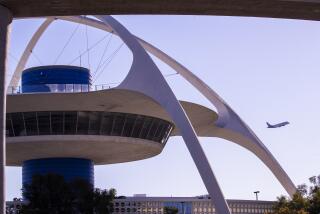Pilots Have Harsh Words for O.C. Airport : FAA reports: ‘I’ve finally had it’ and ‘I would rate traffic control at this airport the worst’ are among the comments.
COSTA MESA — It was an unfamiliar cockpit, and the captain and his second officer were on their first noise-abatement takeoff at John Wayne Airport when they overshot their assigned altitude of 3,000 feet by 500 feet.
In “going through the roof” on that clear day in December, 1988, they were in violation of Federal Aviation Administration and company regulations and risked collision with another aircraft, an FAA safety report said. Their twin-engine turbojet did not hit anything, however, as it rose above the rooftops of Newport Beach.
Although the incident was relatively minor, it shows the complications that can quickly develop during a complex noise-abatement takeoff from John Wayne Airport, the fifth-busiest airport in the nation.
The captain said he exceeded his assigned altitude while trying to engage the sticking controls of the autopilot, keep an eye on his instruments, listen to commands from the tower, level out on his departure route and order his second officer to watch for other aircraft.
“In my opinion, the Santa Ana noise abatement procedures are an extreme menace to aviation safety and should be abandoned at once,” the captain said in an FAA safety report on the incident. “This flight had all the necessary ingredients for disaster: new crew, new aircraft, radical one-of-a-kind maximum performance, totally non-standard departure procedures, heavy general aviation traffic, extremely busy flight deck, high deck angle (28 degrees) making see-and-avoid a complete farce. . . . That airport is an accident waiting to happen.”
That opinion about the airport appears to be widespread among many of those who fly out of John Wayne. According to FAA safety reports, the conflict between safety concerns and noise control at John Wayne is well known to the men and women at the controls of the thundering jetliners and turboprops.
In September, 1986, the noise-abatement procedures were of such concern to one commercial pilot that he filed a safety report with the FAA although he was not involved in any specific mishap.
“I’ve finally had it,” he wrote. “My airline and others have been flying an unsafe takeoff procedure out of the Orange County airport for some time now. . . . Instead of climbing at takeoff thrust with the takeoff flaps set and the retractable landing lights extended and on, as is our normal procedure at all other airports in our system, out of Santa Ana we do not use the landing lights (to decrease drag and therefore climb slightly faster, thus reducing the noise reading). This make us less visually conspicuous.
“Also, we reduce thrust to either climb or cruise setting no later than 1,000 feet . . . This produces a very nose-high, low-speed, low-thrust situation that we maintain until 3,000 feet, where we reselect climb thrust, turn on the extendable landing lights and accelerate to retract the flaps and slats.
“We call this trolling for small aircraft . . “ the captain said.
Nine months later, a jetliner on the same departure route missed a private plane by about 500 feet. Air traffic controllers warned the commercial flight crew about the plane when it was two miles from them. The jet was climbing at such a steep angle, the captain said, that the crew could not see the plane until it was about a mile away, allowing only a few seconds to execute a right turn to get out of the way.
“It was extremely difficult to accurately assess the situation when our aircraft was performing a non-routine noise abatement departure procedure resulting in an unusually high nose altitude. . . .,” the captain wrote in his report. “As compliance with the noise-abatement procedure results in a high cockpit workload, any last-minute surprises are extremely distracting.”
The captain also accused air traffic controllers of routing the private plane into his path and then giving vague information about its position.
A more critical near-miss occurred in January, 1986, when a departing commercial jet and a helicopter coming into the airport missed each other by about 100 feet. The chopper turned out of the way at the last minute, but the commercial pilot said that he was powerless to do anything during takeoff.
“Because of the low speed and altitude, I was unable to take any evasive action,” the captain said. “My only thought was: ‘Unless he gets out of my way, we will hit him.’ In fact, if I had tried to take any evasive action, it may have only compounded the situation by getting in the way of the helicopter whose intentions were a mystery to me. . . . I would rate traffic control at this airport the worst of any airport that I have ever operated through.”
In March, 1990, the crew of a jetliner that was departing John Wayne Airport had forgotten to pressurize the passenger cabin. As the plane climbed to 10,000 feet, oxygen masks in the cabin were deployed. The error, a violation of FAA regulations and company procedures, was corrected immediately, according to an FAA safety report.
The captain said: “The problem was caused, I feel, by the combination of an unusual takeoff configuration coupled with the very complex departure procedure from John Wayne Airport, and associated distractions caused by multiple altitude changes, traffic advisories, power reductions, deck angle changes, etc., necessary to meet noise requirements and/or avoid traffic. The departure from John Wayne Airport should be simplified.”
More to Read
Sign up for Essential California
The most important California stories and recommendations in your inbox every morning.
You may occasionally receive promotional content from the Los Angeles Times.











